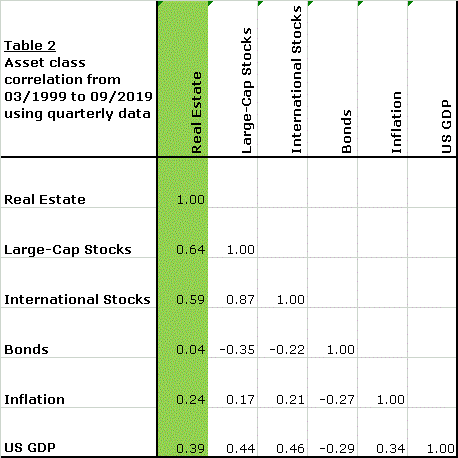
An analysis of returns for real estate, as measured by the FTSE Nareit All Equity REITs index, and large-cap stocks, as measured by the S&P 500, shows that both asset classes have been performing strongly year-to-date. Using these indices, real estate is returning +27.88% and large-cap stocks are +27.63% year-to-date. The table below provides a closer look at returns for real estate and large-cap stocks over 2019 year-to-date, as well as the preceding ten years.

This table shows annual return data for Real Estate and Large-Cap Stocks from 2009 through 2019 year-to-date.
A cursory review of the data shows that the returns for real estate and stocks have appeared to be similar over this period of time. In the investment industry, the similarity of the movement of returns can be measured by correlation. According to Investopedia![]() , correlation measures “the degree to which two securities move in relation to each other”. The correlation coefficient ranges from +1.0 (perfect positive correlation) to -1.0 (perfect negative or inverse correlation). This statistic is useful to portfolio managers as it is a way to represent the diversification benefit of holding two securities, or asset classes, in a portfolio. A perfect positive correlation of +1.0 means the two securities will move exactly together, while a perfect negative correlation of -1.0 means the two securities will move exactly in the opposite direction. While it is often noted that “correlation does not equal causation,” in general, portfolio diversification is best achieved when holding two securities with a low correlation coefficient to each other, as the relative movements, or returns, will not be associated.
, correlation measures “the degree to which two securities move in relation to each other”. The correlation coefficient ranges from +1.0 (perfect positive correlation) to -1.0 (perfect negative or inverse correlation). This statistic is useful to portfolio managers as it is a way to represent the diversification benefit of holding two securities, or asset classes, in a portfolio. A perfect positive correlation of +1.0 means the two securities will move exactly together, while a perfect negative correlation of -1.0 means the two securities will move exactly in the opposite direction. While it is often noted that “correlation does not equal causation,” in general, portfolio diversification is best achieved when holding two securities with a low correlation coefficient to each other, as the relative movements, or returns, will not be associated.
Given that the preceding ten year return data for real estate and stocks appear similar, I thought it would be interesting to closer examine the correlation of real estate to this and other asset classes and indices. The table below, also called a correlation matrix, presents the correlation coefficients between Real Estate (FTSE Nareit All Equity REITs), Large-Cap Stocks (S&P 500), International Stocks (MSCI EAFE), Bonds (Barclays Govt/Credit Intermediate), Inflation (US BLS CPI), and US GDP (representing Economic Growth).

This table shows asset class correlation for Real Estate, Large-Cap Stocks, International Stocks, Bonds, Inflation, and US GDP using quarterly return data from the 1st quarter of 1999 to the 3rd quarter of 2019.
Interestingly, the data shows that the returns for real estate and large-cap stocks have a correlation coefficient of 0.64. This data gives further meaning to the previous observation that the returns for real estate and stocks have appeared to be similar. While positive, this is not an incredibly strong positive correlation. Real estate has a correlation of 0.59 with international stocks. Real estate has a lower correlation with inflation and economic growth, and almost no correlation with bonds.
In looking at correlation alone between real estate, large-cap stocks, international stocks, and bonds, this data shows that the asset classes would not move too closely together, and suggests there would be some benefits to diversification in adding real estate to a portfolio that includes these asset classes.
Washington Trust Bank believes that the information used in this study was obtained from reliable sources, but we do not guarantee its accuracy. Neither the information nor any opinion expressed constitutes a solicitation for business or a recommendation of the purchase or sale of securities or commodities.
Nick is a Vice President and Portfolio Manager for Washington Trust Bank’s Wealth Management & Advisory Services. He offers our clients the expertise to analyze portfolios and unique assets to ensure that they are suitable for meeting our clients’ goals and needs. Nick partners with our Relationship Managers to provide continual analysis to ensure that these customized portfolio solutions maintain the balance between risk and growth in order to ensure continued success in meeting the clients’ goals.